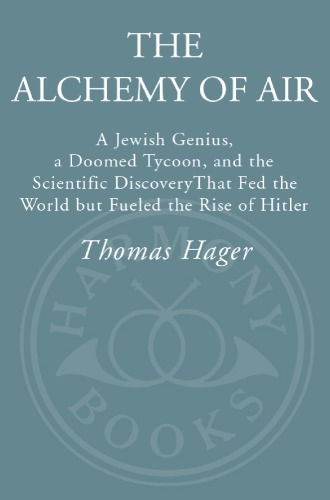
The Alchemy of Air
A Jewish Genius, a Doomed Tycoon, and the Scientific Discovery That Fed the World but Fueled the Rise of Hitler
کتاب های مرتبط
- اطلاعات
- نقد و بررسی
- دیدگاه کاربران
نقد و بررسی

June 23, 2008
Fixed nitrogen (which is immediately usable to plants) is essential in agriculture. Its rarity, as science writer Hager (The Demon Under the Microscope
) shows, dramatically shaped the world and its politics. But by 1905, as Hager details, German chemist Fritz Haber discovered a process for transforming abundant air-borne nitrogen into ammonia, and Carl Bosch’s ingenious engineering scaled Haber’s benchtop chemistry into industrial processes to make fertilizer. But Hager’s story is not only one of triumph, of how Haber and Bosch “invented a way to turn air into bread,” earning a Nobel Prize and saving millions from starvation. This is also a story of irony and tragedy. First, life-saving nitrogen is also the main ingredient in explosives, and Hager cogently summarizes the Haber-Bosch process’s critical role in both world wars. In addition, Hager illustrates Haber’s extreme German patriotism and desperate wish to assimilate; shattered by the rise of Hitler, he became an outcast, abandoned even by his onetime colleague Bosch. It’s unfortunate that Hager ends his fine book with only a brief look at the deleterious role of nitrogen on the environment.

August 1, 2008
This is the story of the Haber-Bosch process, which is the key to manufacturing artificial fertilizerand high explosives. An accomplished science author, Hager taps into recent biographies of Fritz Haber (e.g., Master Mind, written by Daniel Charles in 2005) as he widens his books focus to the problem that Haber received a Nobel Prize for solving. Carl Bosch also received a Nobel for engineering Habers solution into industrial-scale production. The problem was how to convert inert atmospheric nitrogen into ammonia, which is the vital ingredient for making fertilizer. As he explains the intricacies of the Haber-Bosch process, perfected just in time for World War II, author Hager accents personalities, with an emphasis on the tragic elements. Recounting how the patriotic Haber was repaid with expulsion as a Jew by the Nazis, and how the anti-Nazi Bosch saw his industrial accomplishments power the German war machine, Hager successfully dramatizes the chemical substrate of artificial fertilizer and its global ramifications.(Reprinted with permission of Booklist, copyright 2008, American Library Association.)

























دیدگاه کاربران